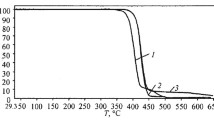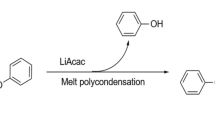Summary
Reactive blending with cyclic anhydrides in the melt is a promising process to modify the chemical structure of bisphenol A polycarbonate (PC) by insertion of ester moieties leading to consistent changes in the chemical and physical properties of PC. In particular, by the reaction with succinic anhydride it is possible to insert aliphatic moieties in the polymer backbone, decreasing the melt viscosity and the glass transition temperature of PC (and thus increase its processability). The reaction, that is catalysed by Lewis acids (e. g. titanium butoxide), proceeds through the formation of carbonyl carbonate groups that undergo decarboxylation leading to ester moieties. No side reactions have been detected by NMR analysis. The addition of phosphorous acid as catalyst quencher at the end of the process gives rise to polymers with good colour and thermal stability.
Similar content being viewed by others
Author information
Authors and Affiliations
Corresponding author
Rights and permissions
About this article
Cite this article
Berti, C., Colonna, M., Fiorini, M. et al. Chemical Modification of Bisphenol A Polycarbonate by Reactive Blending with Cyclic Anhydrides. Polymer Bulletin 51, 111–118 (2003). https://doi.org/10.1007/s00289-003-0202-8
Received:
Revised:
Accepted:
Issue Date:
DOI: https://doi.org/10.1007/s00289-003-0202-8




